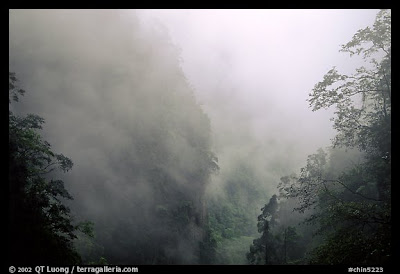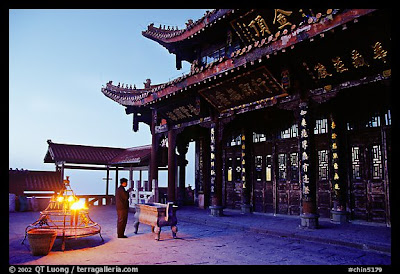Mount Emei (Chinese: 峨嵋山; pinyin: Éméi Shān; Wade–Giles: O2-mei2 Shan1, pronounced [ɤ̌měɪ̯ ʂán]) is a mountain in Sichuan
province, China. Mount Emei is often written as 峨眉山 and occasionally
峩嵋山 or 峩眉山 but all three are translated as Mount Emei or Mount Emeishan:
the word 峨 can mean "high" or "lofty", but the mountain's name is
merely a toponym that carries no additional meaning.
Orographically, Mt. Emei sits at the western rim of the Sichuan Basin. The mountains west of it are known as Daxiangling. A large surrounding area of countryside is geologically known as the Permian Emeishan Large Igneous Province, a large igneous province generated by the Emeishan Traps volcanic eruptions during the Permian Period. At 3,099 metres (10,167 ft), Mt. Emei is the highest of the Four Sacred Buddhist Mountains of China.
Administratively, Mt. Emei (Emeishan) is located near the county-level city of the same name (Emeishan City), which is part of the prefecture-level city of Leshan.
Mt. Emei was made a UNESCO World Heritage Site in 1996.
Mount Emei is one of the Four Sacred Buddhist Mountains of China, and is traditionally regarded as the bodhimaṇḍa, or place of enlightenment, of the bodhisattva Samantabhadra. Samantabhadra is known in Mandarin as Pǔxián Púsà (普賢菩薩).
16th and 17th century sources allude to the practice of martial arts in the monasteries of Mount Emei made the earliest extant reference to the Shaolin Monastery as Chinese boxing's place of origin.
Orographically, Mt. Emei sits at the western rim of the Sichuan Basin. The mountains west of it are known as Daxiangling. A large surrounding area of countryside is geologically known as the Permian Emeishan Large Igneous Province, a large igneous province generated by the Emeishan Traps volcanic eruptions during the Permian Period. At 3,099 metres (10,167 ft), Mt. Emei is the highest of the Four Sacred Buddhist Mountains of China.
Administratively, Mt. Emei (Emeishan) is located near the county-level city of the same name (Emeishan City), which is part of the prefecture-level city of Leshan.
Mt. Emei was made a UNESCO World Heritage Site in 1996.
Mount Emei is one of the Four Sacred Buddhist Mountains of China, and is traditionally regarded as the bodhimaṇḍa, or place of enlightenment, of the bodhisattva Samantabhadra. Samantabhadra is known in Mandarin as Pǔxián Púsà (普賢菩薩).
16th and 17th century sources allude to the practice of martial arts in the monasteries of Mount Emei made the earliest extant reference to the Shaolin Monastery as Chinese boxing's place of origin.


































































No comments:
Post a Comment